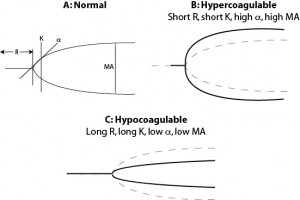With thrombelastography (TEG instruments), a fibrin formation curve is generated, yielding the following results in normal (A), hypercoagulable (B) and hypocoagulable (C) samples:
1. Reaction time (R): The time to onset of fibrin formation (or when the curve deviates by more than 2 mm from midline).
2. K: The time it takes for the curve to deviate 20 mm from the centerline (rate of fibrin formation).
3. α: The angle between the time point K and the centerline (rate of fibrin formation).
4. Maximum amplitude (MA): Strength of the clot.
Given time, the clot will lyse and the percentage of the fibrin clot that has lysed at 30 and 60 minutes (Lys30 and Lys60) after maximal amplitude formation are provided. The initial formed clot (amount and strength) will affect lysis time (weaker smaller clots should lyse quicker).
In hypercoagulable states (B), any of the following may be seen: Quicker time for fibrin formation to start (short R), increased rate of fibrin formation (short K, high α) and increased clot strength (high MA).
In hypocoagulable states (C, any of the following may be seen: Slower time for fibrin formation to start (long R), slower rate of fibrin formation (long K, low α) and decreased clot strength (low MA).
Note that similar results are obtained with thromboelastrometry (ROTEM) although the terminology of results is different.
There is variability among investigators as to the individual or combination of test results that are used to define these three hemostatic states (norm-, hyper- and hypocoagulable). Some investigators use one abnormality, whereas others define an abnormal tracing as two or more abnormalities. A mathematical derivation of various test results, called the overall coagulation index, can be obtained and used to define one of these three states. In addition, an elastic shear modulus (G) can be provided, which is based on a mathematical calculation of MA. This modulus has also been used by some investigators to define the three hemostatic states, but a similar definition can be obtained just from MA (since G is a mathematical derivation of MA).

